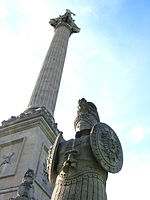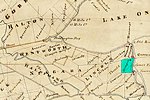Fort Drummond (Queenston Heights)
Forts in OntarioForts or trading posts on the National Historic Sites of Canada registerNational Historic Sites in OntarioUse Canadian English from January 2023War of 1812 National Historic Sites of Canada ... and 1 more
War of 1812 forts
Fort Drummond was the site of a redoubt and battery from the War of 1812 and located within Queenston Heights.The U-shaped structure was an earthworks rather than a wood, brick or rock construction. Built in 1814 by the British Army and named for Sir Gordon Drummond, it was occupied by the Americans for two weeks in July 1814 during the Battle of Chippawa. It was later re-taken by the British. A wading pond, added in the 1920s and replaced in 1967, is located within the site. The walls of the redoubt can still be seen.Other fortifications are located nearby, since the area was close to the border with the United States: Fort Mississauga (1814–1816) Fort George, Ontario (1802)
Excerpt from the Wikipedia article Fort Drummond (Queenston Heights) (License: CC BY-SA 3.0, Authors).Fort Drummond (Queenston Heights)
Niagara Parkway,
Geographical coordinates (GPS) Address Nearby Places Show on map
Geographical coordinates (GPS)
| Latitude | Longitude |
|---|---|
| N 43.160147 ° | E -79.052234 ° |
Address
Queenston Heights Restaurant
Niagara Parkway
L0S 1L0
Ontario, Canada
Open on Google Maps








